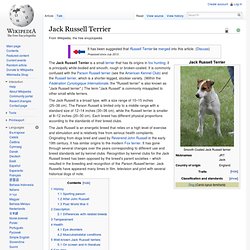

Welsh Corgi. The Welsh corgi is a small type of herding dog that originated in Wales.
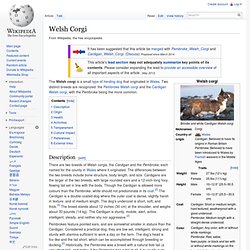
Two distinct breeds are recognized: the Pembroke Welsh corgi and the Cardigan Welsh corgi, with the Pembroke being the more common. Description[edit] Corgis are herding dogs, and perform their duties by nipping at the heels; the dog's low stature allows it to avoid being kicked in the process.[2] As herding dogs, corgis work livestock differently than other breeds. Instead of gathering the cattle the way a collie would, by running around the livestock, corgis drive the herd forward by nipping at their heels and working them from behind in semicircles. Seldom giving ground, if an animal should turn and charge, the corgi will bite its nose, causing it to turn and rejoin the herd.[3] Although they specialize in herding cattle, corgis are also used to herd sheep and Welsh ponies.[5] They are also one of the few breeds able to herd geese.
Welsh corgis also guarded children and were pets.[3] Pembroke Welsh corgi Origin[edit] St. Bernard (dog) The St.

Bernard is a breed of very large working dog from the Italian and Swiss Alps, originally bred for rescue. The breed has become famous through tales of alpine rescues, as well as for its enormous size. Appearance A St. Bernard with short coat History A St. Rottweiler. The Rottweiler was employed in its traditional roles until the mid-19th century when railways replaced droving for herding livestock to market.

While still used in herding, Rottweilers are now used as search and rescue dogs, as guide dogs for the blind, as guard dogs or police dogs, and in other roles.[2] History Rottweiler memorial in Rottweil, Germany Although a versatile breed used in recent times for many purposes, the Rottweiler is one of the oldest of herding breeds. A multi-faceted herding and stock protection dog, it is capable of working all kinds of livestock under a variety of conditions.[3] The breed's history likely dates to the Roman Empire.[4] It is likely that the Rottweiler is a descendant of ancient Roman drover dogs, a mastiff-type dog that was a dependable, rugged dog with great intelligence and guarding instincts.
The buildup to World War I saw a great demand for police dogs, and that led to a revival of interest in the Rottweiler. Technical description Head Neck Body Tail. Doberman Pinscher. The Doberman Pinscher (alternatively spelled Dobermann in many countries) or simply Doberman, is a breed of domestic dog originally developed around 1890 by Karl Friedrich Louis Dobermann, a tax collector from Germany.
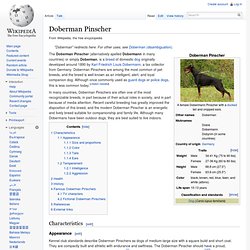
Beagle. Beagles have been depicted in popular culture since Elizabethan times in literature and paintings, and more recently in film, television and comic books.
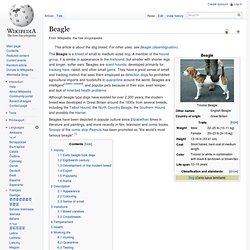
Snoopy of the comic strip Peanuts has been promoted as "the world's most famous beagle".[1] History[edit] Early beagle-type dogs[edit] Dogs of similar size and purpose to the modern Beagle[a] can be traced in Ancient Greece[2] back to around the 5th century BC. Xenophon, born around 430 BC, in his Treatise on Hunting or Cynegeticus refers to a hound that hunted hares by scent and was followed on foot. From medieval times, beagle was used as a generic description for the smaller hounds, though these dogs differed considerably from the modern breed. Little small mitten-beagle, which may be companion for a ladies kirtle, and in the field will run as cunningly as any hound whatere, only their musick is very small like reeds.[7] Eighteenth century[edit]
Golden Retriever. The Golden Retriever is a large-sized breed of dog.
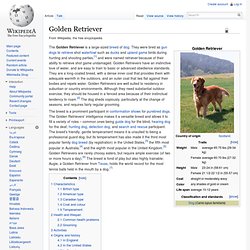
They were bred as gun dogs to retrieve shot waterfowl such as ducks and upland game birds during hunting and shooting parties,[1] and were named retriever because of their ability to retrieve shot game undamaged. Golden Retrievers have an instinctive love of water, and are easy to train to basic or advanced obedience standards. They are a long-coated breed, with a dense inner coat that provides them with adequate warmth in the outdoors, and an outer coat that lies flat against their bodies and repels water.
Golden Retrievers are well suited to residency in suburban or country environments. Although they need substantial outdoor exercise, they should be housed in a fenced area because of their instinctual tendency to roam.[2] The dog sheds copiously, particularly at the change of seasons, and requires fairly regular grooming. Characteristics British type The Golden Retriever was first bred in Scotland. American type Canadian type Grooming. Poodle. Toy Poodles won "Best in Show" at Crufts in 1966 and 1982.
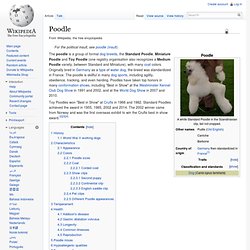
Standard Poodles achieved the award in 1955, 1985, 2002 and 2014. Fox Terrier. Fox Terriers are two different breeds of the terrier dog type: the Smooth Fox Terrier and the Wire Fox Terrier.
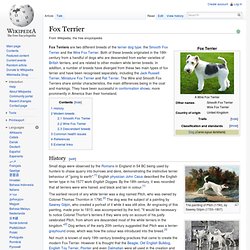
Both of these breeds originated in the 19th century from a handful of dogs who are descended from earlier varieties of British terriers, and are related to other modern white terrier breeds. German Shepherd. Jack Russell Terrier. The Jack Russell Terrier is a small terrier that has its origins in fox hunting; it is principally white-bodied and smooth, rough or broken-coated.
